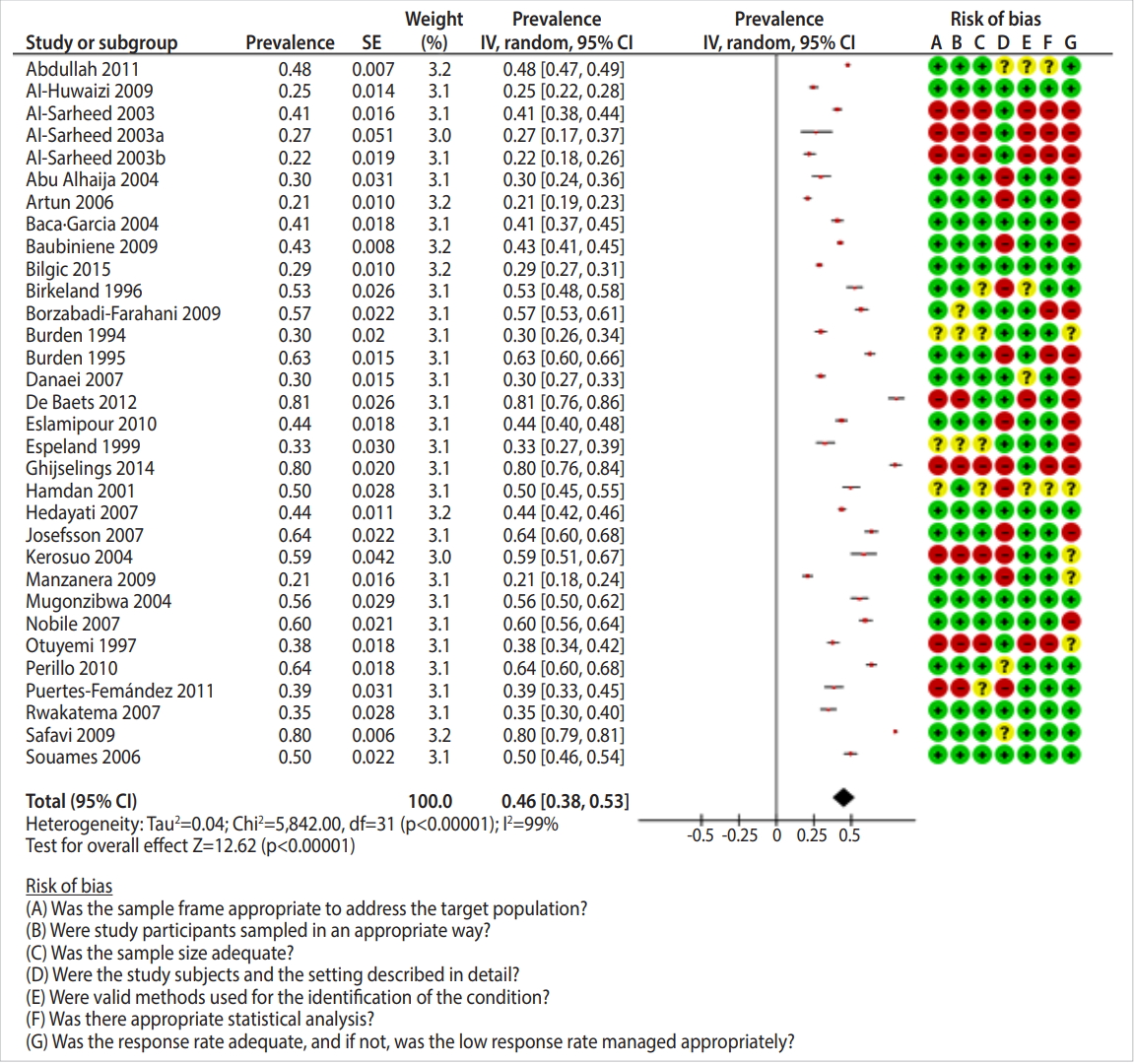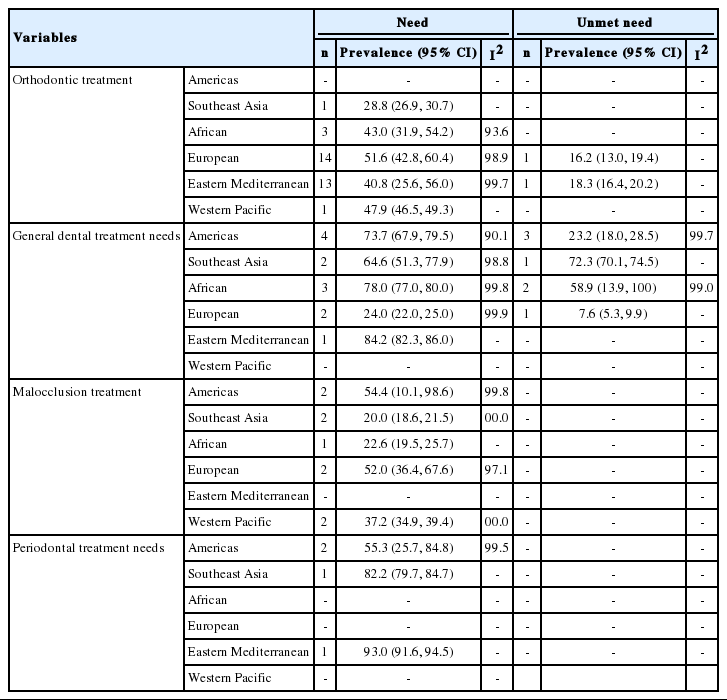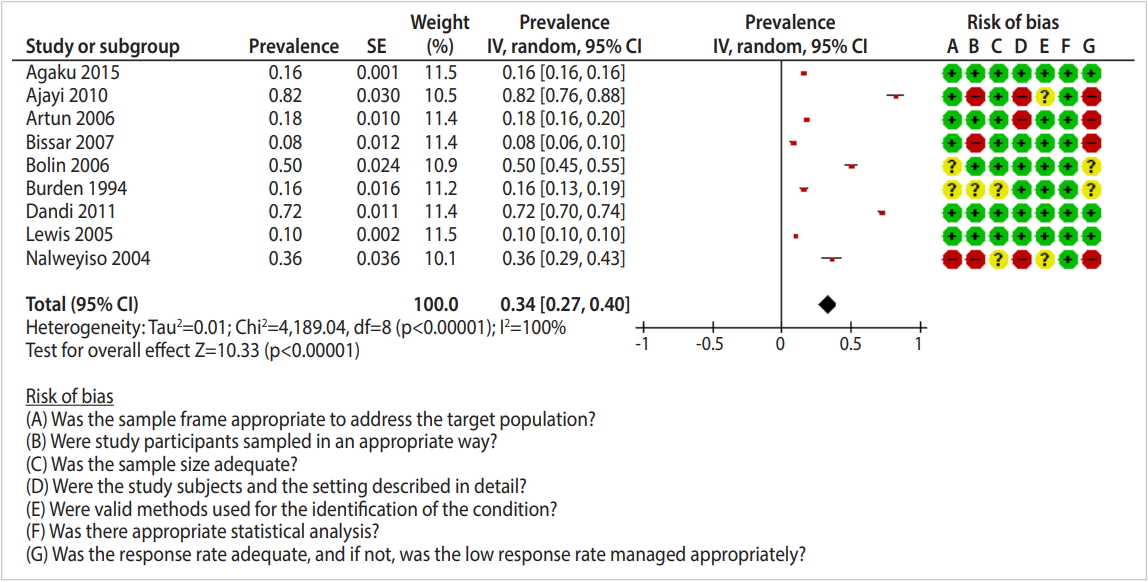The global prevalence of dental healthcare needs and unmet dental needs among adolescents: a systematic review and meta-analysis
Article information
Abstract
OBJECTIVES
Access to dental healthcare services is a major determinant of dental health in communities. This meta-analysis was conducted to estimate the global prevalence of dental needs and of unmet dental needs in adolescents.
METHODS
PubMed, Web of Science, and Scopus were searched in June 2018. The summary measures included the prevalence of met and unmet dental needs. A meta-analysis was performed using the inverse variance method to obtain pooled summary measures. Out of 41,661 retrieved articles, 57 were ultimately included.
RESULTS
The pooled prevalence of orthodontic treatment needs was 46.0% (95% confidence interval [CI], 38.0 to 53.0), that of general treatment needs was 59.0% (95% CI, 42.0 to 75.0), that of periodontal treatment needs was 71.0% (95% CI, 46.0 to 96.0), and that of malocclusion treatment needs was 39.0% (95% CI, 28.0 to 50.0). The pooled prevalence of unmet dental needs was 34.0% (95% CI, 27.0 to 40.0).
CONCLUSIONS
The highest and lowest prevalence of unmet dental needs were found in Southeast Asia and Europe, respectively. The prevalence of dental needs was higher in the countries of the Americas and Europe than in other World Health Organization (WHO) regions. The prevalence of unmet dental needs was higher in Southeast Asia and Africa than in other WHO regions.
INTRODUCTION
Access to dental healthcare services is a major determinant of dental health in communities. Dental problems, including dental cavities, are most prevalent among adolescents [1].
The global weighted means of decayed, missing, and filled teeth for adolescents aged 12 years old in 2011 and 2015 were 1.67 and 1.86, respectively [2]. In 2010, approximately 2.4 billion people and 621 million children were affected by untreated caries in permanent and deciduous teeth, respectively, and untreated caries in permanent teeth was the most prevalent dental condition worldwide [3]. In the USA, it was reported that 21% of children aged 6-11 years and 58% of adolescents aged 12-19 years had experienced dental caries. In 2011-2012, the prevalence of untreated dental caries was about 6.0% in children and 15.3% in adolescents [4].
Untreated dental cavities have been reported to cause severe pain, infection, and problems with eating, speaking, and learning in children and adolescents [1].
Adolescents constitute a noteworthy age group, as they have specific healthcare needs [5]. Dental healthcare is an important need in this group, given its effects on quality of life and its potential to improve general health. Dental problems remain a huge burden in children and adolescents in certain regions of the world [6]; nevertheless, the prevalence of dental needs in these age groups has not been estimated in some communities [7,8].
Unmet healthcare needs have been defined as the difference between the healthcare services required to cope with a health problem and the services received [9]. Unmet healthcare needs are common in adolescents and are an independent risk factor for health outcomes in adults [10], meaning that they can impose heavy costs on the community, health system, and individuals [7]. Unmet dental needs in adolescents can have consequences that affect quality of life in adulthood. Several studies have been published regarding the prevalence of needs and unmet needs for dental healthcare. However, there are discrepancies in the results of the published studies. The present systematic review and meta-analysis was therefore conducted to estimate the global prevalence of dental needs and unmet dental needs in adolescents by the type of dental care, World Health Organization (WHO) region, and sex.
MATERIALS AND METHODS
The design of this study is a systematic review and meta-analysis.
As part of a comprehensive systematic review, the present review was conducted to determine the prevalence of dental healthcare needs and unmet dental needs in adolescents. This systematic review was conducted and reported according to the PRISMA (Preferred Reporting Items for Systematic Reviews and Meta-Analyses) [11] (Supplementary Material 1).
Eligibility criteria
The present review included all retrieved cross-sectional studies that were conducted to estimate dental healthcare needs and unmet dental needs in adolescents. The studies included were not limited regarding the year, location, or language of the study, the sex and race of adolescents studied, or the type of dental health needs and unmet needs studied. According to the WHO, adolescents include individuals aged 10-19 years [12].
Unmet needs were defined as the difference between the healthcare needs present and the healthcare needs that were fulfilled to address the health problems under consideration [9].
Identifying the relevant studies
The international databases PubMed, Web of Science, and Scopus were searched in June 2018. The keywords used for searching PubMed were as follows: (adolescent [MeSH Terms] OR “teen” [Text Word] OR homeless youth [MeSH Terms] OR “street adolescents” [Text Word]) AND (health services needs and demand [MeSH Terms] OR “unmet needs” [Text Word] OR needs assessment [MeSH Terms] OR “health needs” [Text Word] OR “unmet health needs” [Text Word] OR “health service needs” [Text Word] OR “delay medical care” [Text Word]) AND (oral health [MeSH Terms] OR dental health services [MeSH Terms]). In Web of Science and Scopus, we searched the mentioned keywords as the topic (TS) and TITLE-ABS-KEY, respectively.
Data extraction and assessing the risk of bias
Endnote X7 software was used to the manage the results of our initial search. Two authors (TN and SBC) were in charge of screening the titles and abstracts of the studies obtained from the databases. The full texts of the selected studies were then evaluated based on the eligibility criteria. Any disagreements between the investigators were resolved through discussion and consultation with a third author (ADI). The kappa value for agreement between two authors in the screening of the title and abstract was 84%.
Three authors (TN, SBC, and ADI) were responsible for data extraction. The data extracted from the included studies comprised the name of the first author, the year of publication, the location (country) of the study, the type of study population, the sex and mean/median age of participants, the type of health need(s) and unmet need(s), the sample size, the number of participants with health needs, and the number of participants with unmet health needs.
Two authors (TN and SBC) were in charge of quality assessments. The Joanna Briggs Institute critical appraisal checklist was used for evaluating the studies that reported prevalence rates and for assessing the risk of bias [13]. The items selected from the Joanna Briggs Institute checklist included (1) the appropriateness of the sampling frame in terms of addressing the target population, (2) the appropriateness of the sampling method, (3) the adequacy of the sample size, (4) the provision of a detailed description of the subjects and the study setting, (5) the use of a valid method for identifying the outcomes (i.e., dental needs and unmet dental needs), (6) the appropriateness of the statistical analysis, and (7) the adequacy of the response rate and the appropriate management of a potential low rate.
Statistical analysis
The chi-square test was used to examine heterogeneity among the results of the included studies. Between-study variance was assessed using the tau-square test, and the I-square statistic was used to quantify heterogeneity [14].
The summary measures, including the prevalence of dental healthcare needs and unmet dental needs, were extracted from the included studies, and their standard errors were calculated. Meta-analysis was performed using the inverse variance method to obtain the pooled summary measure. In the cases of out-of-range confidence intervals (CIs) in the subgroup analysis, the metaprop command was used. A random-effects model was also applied. A p-value of less than 0.05 was considered to indicate statistical significance. The data were analyzed in Review Manager 5.3 (Cochrane Collaboration, Copenhagen, Denmark) and Stata version 11 (StataCorp., College Station, TX, USA).
Ethics statement
The study protocol was approved by the Ethics Committee of Hamadan University of Medical Sciences (IR.UMSHA.RES.1397.69).
RESULTS
Included studies
Out of the 41,661 studies retrieved from searching the international databases and 62 found from scanning the references of the selected studies, 57 studies [15-71] were ultimately included in this systematic review (Figure 1). A study by Al-Sarheed et al. [22] was divided into 3 studies for the purposes of this analysis because it reported dental healthcare needs in 3 groups of adolescents: the general population, visually-impaired adolescents, and adolescents with hearing loss. Table 1 presents the characteristics of the included studies, which included 167,316 adolescents who were evaluated in terms of their dental healthcare needs and 123,821 who were evaluated in terms of their unmet dental healthcare needs. Results of the risk of bias assessment are shown in the forest plots in Figures 2-4.

Flowchart depicting the stages through which articles were retrieved and eligibility criteria were checked for the meta-analysis.

Prevalence of orthodontic treatment needs among adolescents. SE, standard error; CI, confidence interval; df, degree of freedom.

Prevalence of (A) general dental treatment needs, (B) periodontal treatment needs, and (C) malocclusion treatment needs among adolescents. SE, standard error; CI, confidence interval; df, degree of freedom.
Prevalence of dental healthcare needs
The overall prevalence of dental healthcare needs was 49.0% (95% CI, 42.0 to 56.0) across all types of dental care. Table 2 presents the overall prevalence by WHO region, sex, and year of publication of the study. The present review reported the prevalence of each type of dental healthcare need. Orthodontic treatment needs were reported in 54.2% of the studies, general needs in 23.7%, periodontal needs in 6.8%, and malocclusion needs in 12.3%.

Prevalence of any dental healthcare need and unmet needs among adolescents based on WHO region and sex
The prevalence of orthodontic treatment needs was reported in 32 studies. The pooled prevalence of orthodontic treatment needs was 46.0% (95% CI, 38.0 to 53.0; I2=99%) (Figure 2). With regard to WHO region, the highest prevalence was associated with countries in Europe (51.6%; 95% CI, 42.8 to 60.4) and the lowest with countries in Southeast Asia (28.8%; 95% CI, 26.9 to 30.7) (Table 3).

Prevalence of specific dental healthcare needs and unmet needs among adolescents based on WHO region
Twelve studies reported the prevalence of general treatment needs in adolescents. The pooled prevalence of general treatment needs was 59.0% (95% CI, 42.0 to 75.0) (Figure 3A). The highest prevalence rates were found in the Eastern Mediterranean region (84.2%; 95% CI, 82.3 to 86.0) and the Africa (78.0%; 95% CI, 77.0 to 80.0). The lowest prevalence was observed in Europe (24.0%; 95% CI, 22.0 to 25.0).
None of the 12 studies were conducted in the Western Pacific region (Table 3).
The pooled prevalence of periodontal treatment needs was 71.0% (95% CI, 46.0 to 96.0) (Figure 3B). The highest prevalence, 93.0% (95% CI, 91.6 to 94.5), was found in the Eastern Mediterranean region (Table 3).
Nine studies reported the prevalence of malocclusion treatment needs in adolescents. The pooled prevalence of this type of need was 39.0% (95% CI, 28.0 to 50.0) (Figure 3C).
Prevalence of unmet dental healthcare needs
Nine studies reported the prevalence of unmet dental healthcare needs. The pooled prevalence of unmet dental needs was 34.0% (95% CI, 27.0 to 40.0) (Figure 4). The highest prevalence of unmet needs was found in Southeast Asia (72.3%; 95% CI, 70.1 to 74.5) and the lowest in Europe (11.8%; 95% CI, 3.4 to 20.3) (Table 2). Table 3 presents the prevalence of unmet needs by type of dental need and WHO region.
DISCUSSION
According to the results of the present systematic review, dental healthcare is a major global need in adolescents. Across all types of dental care, about 50% of adolescents worldwide were found to require dental healthcare services, and 34.0% were found to have unmet dental healthcare needs. The highest prevalence of these needs was observed in countries in the Americas and Europe, and the lowest was seen in Africa and the Western Pacific region. The seemingly higher prevalence observed in the Americas and Europe compared to Africa and the Western Pacific can be explained by the lower number of studies conducted in developing countries and their lower sample sizes compared to studies conducted in developed countries. The larger number of studies conducted on dental healthcare in developed countries suggests the greater perceived importance of dental health among adolescents in these countries. Developed countries therefore appear to have made more serious efforts than developing countries to identify dental health problems in adolescents.
In contrast, the prevalence of unmet dental healthcare needs was lower in Europe and the Americas than in the other regions of the WHO. This prevalence was higher in Southeast Asia and Africa than in the other regions. Unmet dental needs therefore appear to be mainly associated with developing countries. In low-income and middle-income countries, the cost of dental healthcare can put a substantial financial burden on households [72]. In addition, members of the general public in these countries are not adequately protected against the high costs of dental healthcare [72]. A study conducted in Iran showed that the cost of essential dental care was an important determinant of catastrophic healthcare expenditures [73]. The high expenditures required for dental healthcare and the lack of associated insurance coverage in many countries, especially low-income and middle-income countries, can contribute to the high prevalence of unmet dental healthcare needs in these countries.
Globally, unmet dental needs are common in adolescents. Unmet dental needs are an independent risk factor for oral health outcomes in adulthood [10], meaning that they can impose a high burden on the community, health system, and individuals [7]. Therefore, addressing unmet dental needs is important in terms of public health. Unmet dental needs affect the dental health-associated quality of life in adolescents [74]. Improving dental healthcare services and meeting dental healthcare needs can therefore promote overall quality of life in adolescents; nevertheless, given the high expenditures required for dental healthcare, policy-makers are recommended to more effectively provide households with the financial support they need for this highly expensive care. Moreover, the total number of people with unmet oral healthcare needs increased from 2.5 billion in 1990 to 3.5 billion in 2015, suggesting that oral health remains a global public health challenge [75], as emphasized by the global results of the present study in adolescents.
Worldwide, there is a lack of knowledge about certain types of dental healthcare needs; for instance, no compelling evidence was found regarding the global prevalence of unmet periodontal and malocclusion treatment needs. The lack of knowledge regarding the prevalence of unmet dental healthcare needs is more serious at a global than at a local scale. The 9 studies included in the present review regarding unmet dental needs were limited to unmet general and orthodontic dental treatment needs. We therefore recommend that further studies be conducted on unmet dental healthcare needs in adolescents, especially in low-income and middle-income countries.
The present systematic review and meta-analysis was faced with high heterogeneity between the results obtained in the included studies. Homogeneity was not achieved, despite conducting the subgroup analysis by WHO region and type of dental healthcare. The high heterogeneity observed can be explained by differences in the setting, time, and location of studies, in the type of dental healthcare, in the methods of evaluating of dental health needs and unmet needs, and in the quality of the included studies.
The major limitations of the present systematic review and meta-analysis included the low quality of some of the included studies and their use of different tools and criteria for detecting dental healthcare needs. In addition, our results may be affected by selection bias due to lack of access to the full text of some papers as well as the potential existence of studies in the gray literature, such as theses and annual unpublished reports by nations regarding the prevalence of need and unmet needs.
CONCLUSION
The results obtained from this systematic review suggest that the prevalence of dental healthcare needs and unmet dental healthcare needs is globally significant in adolescents. The prevalence of dental healthcare needs was higher in the countries of the Americas and Europe than in other WHO regions. Unmet needs were more prevalent in Southeast Asia and Africa than in other WHO regions.
SUPPLEMENTARY MATERIALS
Supplementary material is available at http://www.e-epih.org/.
epih-41-e2019046-supplementary.pdfNotes
The authors have no conflicts of interest to declare for this study.
AUTHOR CONTRIBUTIONS
Conceptualization: MG, ADI. Data curation: SBC, TN, ADI. Formal analysis: ADI. Methodology: ADI, SBC, TN. Funding acquisition: ADI. Project administration: MG. Visualization: MG, ADI, TN, SBC. Writing – original draft: MG, ADI, TN, SBC. Writing – review & editing: MG, ADI, TN, SBC.
Acknowledgements
We would like to thank the Vice Chancellor for Research and Technology at Hamadan University of Medical Sciences for the support of this study (ID: 970225943).


